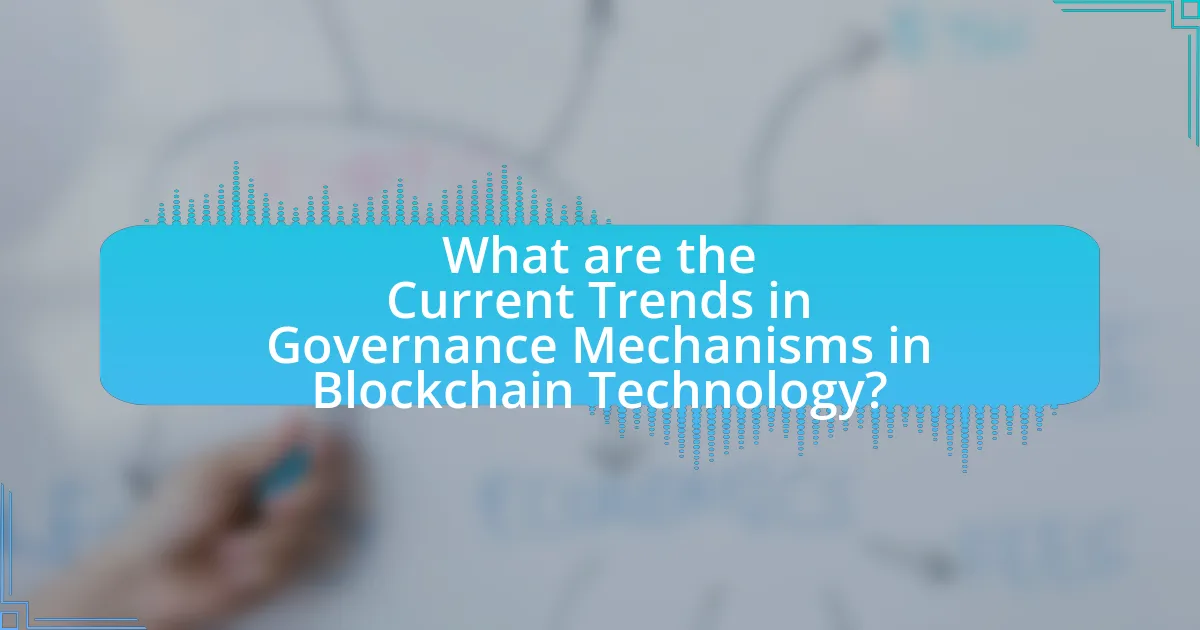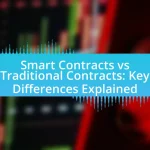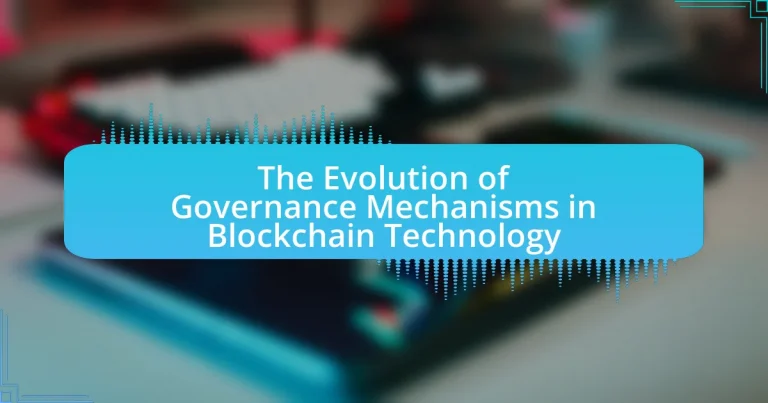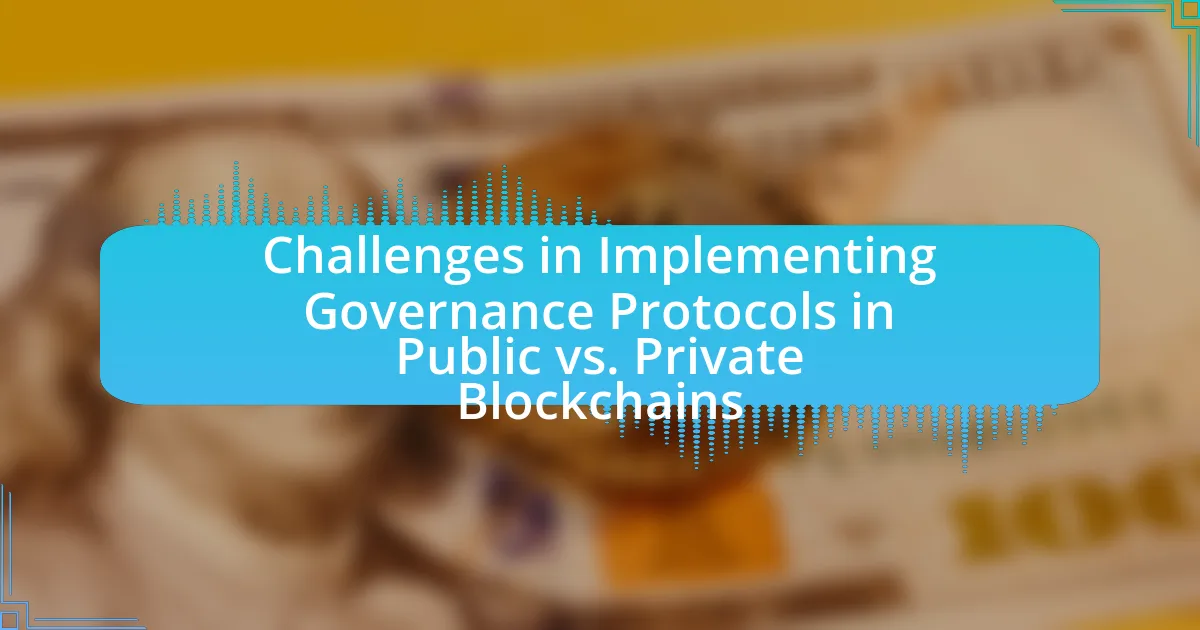Governance mechanisms in blockchain technology are essential frameworks that determine decision-making processes within decentralized networks. This article explores the evolution of these mechanisms, highlighting key components such as consensus protocols, stakeholder participation, and regulatory compliance. It examines the historical development from Bitcoin’s basic governance model to the emergence of decentralized autonomous organizations (DAOs) and hybrid governance structures. Additionally, the article discusses current trends, challenges, and best practices for enhancing governance effectiveness, emphasizing the importance of transparency and community engagement in fostering trust and adaptability in blockchain systems.

What are Governance Mechanisms in Blockchain Technology?
Governance mechanisms in blockchain technology are frameworks and processes that dictate how decisions are made within a blockchain network. These mechanisms can include on-chain governance, where changes are proposed and voted on directly within the blockchain protocol, and off-chain governance, which involves discussions and decisions made outside the blockchain, often through community forums or social media. For instance, Bitcoin employs a more informal off-chain governance model, while Ethereum has implemented on-chain governance through its Improvement Proposal (EIP) process. The effectiveness of these mechanisms is evidenced by their ability to facilitate consensus among stakeholders, manage upgrades, and resolve disputes, thereby ensuring the network’s stability and adaptability.
How do Governance Mechanisms function within Blockchain systems?
Governance mechanisms within blockchain systems function by establishing rules and processes for decision-making, ensuring that all stakeholders can participate in the management and evolution of the network. These mechanisms can be categorized into on-chain and off-chain governance; on-chain governance involves protocols that allow stakeholders to vote on changes directly within the blockchain, while off-chain governance relies on external discussions and agreements among community members. For example, the Ethereum network utilizes a combination of both, where on-chain proposals are discussed in community forums before being implemented. This dual approach helps maintain transparency and inclusivity, which are critical for the legitimacy and sustainability of blockchain systems.
What are the key components of Governance Mechanisms in Blockchain?
The key components of governance mechanisms in blockchain include consensus protocols, stakeholder participation, decision-making processes, and regulatory compliance. Consensus protocols, such as Proof of Work or Proof of Stake, ensure agreement among network participants on the validity of transactions. Stakeholder participation allows users to influence governance through voting or proposals, fostering a decentralized decision-making environment. Decision-making processes define how changes to the protocol or network are proposed, debated, and implemented, often involving community consensus. Regulatory compliance ensures that the blockchain adheres to legal standards, which can vary by jurisdiction, impacting governance structures. These components collectively shape how blockchain networks operate and evolve, ensuring transparency, security, and adaptability.
How do these components interact to facilitate governance?
The components of blockchain technology, such as consensus mechanisms, smart contracts, and decentralized governance structures, interact to facilitate governance by ensuring transparency, security, and stakeholder participation. Consensus mechanisms, like Proof of Stake or Proof of Work, validate transactions and maintain the integrity of the blockchain, which fosters trust among participants. Smart contracts automate governance processes by executing predefined rules without the need for intermediaries, thereby reducing the potential for manipulation. Decentralized governance structures empower stakeholders to propose and vote on changes, ensuring that decision-making reflects the collective interests of the community. This interaction creates a robust framework for governance that is resilient, efficient, and aligned with the principles of decentralization inherent in blockchain technology.
Why are Governance Mechanisms important in Blockchain Technology?
Governance mechanisms are important in blockchain technology because they establish the rules and processes for decision-making within decentralized networks. These mechanisms ensure that all stakeholders have a voice in the governance process, which is crucial for maintaining trust and transparency. For instance, effective governance can prevent centralization of power, as seen in the case of Bitcoin, where community consensus is required for protocol changes. Additionally, governance mechanisms facilitate conflict resolution and adaptation to technological advancements, which are essential for the long-term sustainability of blockchain projects.
What challenges do Governance Mechanisms address in Blockchain?
Governance mechanisms in blockchain address challenges such as decision-making inefficiencies, lack of accountability, and conflict resolution. These mechanisms establish frameworks that facilitate consensus among stakeholders, ensuring that decisions are made transparently and inclusively. For instance, decentralized autonomous organizations (DAOs) utilize smart contracts to automate governance processes, thereby reducing the potential for disputes and enhancing operational efficiency. Additionally, governance mechanisms help mitigate risks associated with centralization, which can lead to vulnerabilities and manipulation, as evidenced by incidents in various blockchain networks where centralized control resulted in security breaches.
How do Governance Mechanisms enhance trust and transparency?
Governance mechanisms enhance trust and transparency by establishing clear rules and processes for decision-making within blockchain networks. These mechanisms, such as decentralized autonomous organizations (DAOs) and consensus protocols, ensure that all participants have a voice and can verify actions taken on the network. For instance, the use of smart contracts automates and enforces agreements without the need for intermediaries, reducing the potential for manipulation. Additionally, transparent ledger systems allow all transactions to be publicly accessible and auditable, fostering accountability among participants. Research by Catalini and Gans (2016) highlights that transparency in blockchain systems can significantly reduce information asymmetry, thereby increasing trust among users.

What are the Historical Developments of Governance Mechanisms in Blockchain?
The historical developments of governance mechanisms in blockchain began with Bitcoin’s introduction in 2009, which utilized a decentralized consensus model through proof-of-work. This model established a foundational governance structure where miners validated transactions, but decision-making was limited to protocol changes proposed by developers. In 2015, Ethereum expanded governance by introducing smart contracts, allowing for more complex decentralized applications and community-driven proposals through mechanisms like the Ethereum Improvement Proposal (EIP) process.
Subsequently, the rise of decentralized autonomous organizations (DAOs) in 2016, exemplified by The DAO project, showcased a new governance model where token holders could vote on funding proposals, although it faced challenges due to security vulnerabilities. In 2017, the introduction of delegated proof-of-stake (DPoS) by platforms like EOS further evolved governance by allowing token holders to elect delegates responsible for validating transactions and making protocol decisions, thus enhancing scalability and community involvement.
By 2020, governance mechanisms had diversified significantly, with projects like Compound and MakerDAO implementing on-chain governance where token holders could vote on protocol changes and risk parameters, reflecting a trend towards more democratic and participatory governance structures. These historical developments illustrate the ongoing evolution of governance in blockchain, transitioning from simple consensus models to complex, community-driven frameworks that empower users in decision-making processes.
How have Governance Mechanisms evolved since the inception of Blockchain?
Governance mechanisms in blockchain have evolved from simple consensus models to complex frameworks incorporating decentralized governance and community participation. Initially, early blockchains like Bitcoin utilized a rudimentary governance structure based on proof-of-work consensus, where miners validated transactions and made protocol changes through informal discussions. As the technology matured, projects like Ethereum introduced more sophisticated governance models, including on-chain voting and decentralized autonomous organizations (DAOs), allowing stakeholders to propose and vote on changes directly. This evolution reflects a shift towards greater inclusivity and transparency, as evidenced by the rise of platforms like Aragon and Compound, which empower users to actively participate in governance decisions.
What were the initial Governance Mechanisms used in early Blockchain systems?
The initial governance mechanisms used in early blockchain systems primarily included consensus algorithms, community voting, and social contracts. Consensus algorithms, such as Proof of Work in Bitcoin, ensured agreement among network participants on the validity of transactions. Community voting allowed stakeholders to influence decisions regarding protocol changes or upgrades, exemplified by the discussions within the Bitcoin community about forks. Social contracts, often informal, established norms and expectations among users, guiding behavior and decision-making within the network. These mechanisms laid the foundation for governance in blockchain technology, balancing decentralization with the need for coordination among participants.
How did community-driven governance models emerge?
Community-driven governance models emerged as a response to the limitations of traditional hierarchical governance structures, particularly in decentralized systems like blockchain technology. These models prioritize collective decision-making and stakeholder participation, allowing communities to have a direct influence on governance processes. The rise of blockchain platforms, such as Ethereum, demonstrated the need for inclusive governance mechanisms that reflect the interests of diverse stakeholders, leading to the development of decentralized autonomous organizations (DAOs). DAOs utilize smart contracts to facilitate transparent and democratic decision-making, enabling community members to propose and vote on changes. This shift towards community-driven governance is supported by the increasing demand for transparency, accountability, and user empowerment in digital ecosystems.
What role do forks play in the evolution of Governance Mechanisms?
Forks play a critical role in the evolution of governance mechanisms by enabling communities to make decisions about protocol changes and to resolve disputes. When a blockchain network experiences a disagreement among its participants regarding the direction of the protocol, a fork can occur, resulting in a split that allows for alternative governance structures to emerge. For instance, the Bitcoin and Bitcoin Cash split in 2017 exemplifies how forks can reflect differing governance philosophies, with Bitcoin prioritizing stability and Bitcoin Cash advocating for larger block sizes to enhance transaction capacity. This dynamic illustrates that forks not only serve as a technical solution to disagreements but also as a means for communities to express their governance preferences, thereby shaping the overall governance landscape in blockchain technology.
What are the implications of hard forks on governance?
Hard forks significantly impact governance by creating divergent paths for blockchain protocols, which can lead to fragmentation within the community. When a hard fork occurs, it often results in two separate chains, each with its own set of rules and governance structures, which can create confusion and conflict among stakeholders. For instance, the Bitcoin and Bitcoin Cash split in 2017 exemplifies how differing governance philosophies can lead to the establishment of competing networks, each with its own community and decision-making processes. This fragmentation can weaken the overall governance of the original blockchain, as resources and attention are divided, potentially hindering effective decision-making and consensus-building.
How do soft forks influence governance decisions?
Soft forks influence governance decisions by allowing a blockchain network to implement changes without requiring a complete consensus from all participants. This mechanism enables developers to introduce new features or modifications that are backward-compatible, meaning that nodes that do not upgrade can still operate on the network. For instance, the Bitcoin network’s soft fork in 2017, known as Segregated Witness (SegWit), demonstrated how a soft fork can facilitate governance by addressing scalability issues while maintaining the integrity of the existing system. This approach can lead to more agile decision-making processes, as it reduces the need for contentious hard forks, which often result in splits within the community.

What are the Current Trends in Governance Mechanisms in Blockchain Technology?
Current trends in governance mechanisms in blockchain technology include decentralized autonomous organizations (DAOs), on-chain governance, and hybrid governance models. DAOs enable community-driven decision-making, allowing stakeholders to vote on proposals directly, which enhances transparency and inclusivity. On-chain governance facilitates real-time voting and protocol upgrades through smart contracts, exemplified by projects like Tezos and Aragon, which streamline the governance process. Hybrid governance models combine on-chain and off-chain elements, as seen in platforms like MakerDAO, where governance decisions are made through a mix of community voting and expert input. These trends reflect a shift towards more participatory and efficient governance structures in blockchain ecosystems.
How are decentralized autonomous organizations (DAOs) shaping governance?
Decentralized autonomous organizations (DAOs) are reshaping governance by enabling decentralized decision-making and enhancing transparency in organizational operations. DAOs utilize smart contracts on blockchain technology to automate governance processes, allowing stakeholders to participate in decision-making without centralized authority. For instance, platforms like Aragon and DAOstack facilitate the creation and management of DAOs, where members can vote on proposals using tokens, ensuring that governance is directly influenced by the community. This model reduces the risk of corruption and increases accountability, as all transactions and decisions are recorded on the blockchain, making them publicly accessible and verifiable.
What are the benefits and challenges of DAOs in governance?
Decentralized Autonomous Organizations (DAOs) offer benefits such as increased transparency, enhanced participation, and reduced centralization in governance. These organizations operate on blockchain technology, allowing for transparent decision-making processes where all members can participate and vote, thus fostering a sense of community and shared ownership. For instance, a study by the World Economic Forum highlights that DAOs can streamline governance by automating processes through smart contracts, which reduces the need for intermediaries and enhances efficiency.
However, DAOs also face challenges, including regulatory uncertainty, potential security vulnerabilities, and difficulties in achieving consensus among diverse stakeholders. The lack of clear legal frameworks can hinder the operation of DAOs, as seen in various jurisdictions where regulations are still evolving. Additionally, smart contracts, while efficient, can be susceptible to bugs and exploits, as evidenced by incidents like the DAO hack in 2016, which resulted in significant financial losses. These challenges highlight the complexities involved in implementing DAOs as a governance mechanism.
How do DAOs differ from traditional governance models?
DAOs, or Decentralized Autonomous Organizations, differ from traditional governance models primarily in their reliance on blockchain technology for decision-making and operations. Unlike traditional governance, which often involves centralized authority and hierarchical structures, DAOs operate on a decentralized framework where decisions are made collectively by stakeholders through smart contracts. This structure enhances transparency and reduces the potential for corruption, as all transactions and decisions are recorded on a public ledger. Furthermore, DAOs enable global participation without geographical constraints, allowing anyone with internet access to contribute to governance processes. This contrasts sharply with traditional models that may limit participation to specific demographics or regions.
What innovations are emerging in Governance Mechanisms?
Innovations emerging in governance mechanisms include decentralized autonomous organizations (DAOs), which leverage smart contracts to automate decision-making processes, enhancing transparency and efficiency. DAOs enable stakeholders to participate in governance through token-based voting systems, allowing for more democratic and inclusive governance structures. Additionally, hybrid governance models are gaining traction, combining on-chain and off-chain governance to balance efficiency with community input. These innovations are supported by the increasing adoption of blockchain technology across various sectors, demonstrating a shift towards more participatory and transparent governance frameworks.
How is on-chain governance being implemented in modern Blockchains?
On-chain governance is being implemented in modern blockchains through mechanisms that allow stakeholders to propose, vote on, and enact changes directly on the blockchain. For example, platforms like Tezos and Decred utilize formal voting systems where token holders can participate in governance decisions, influencing protocol upgrades and changes. In Tezos, a self-amending blockchain, proposals are submitted and voted on by stakeholders, with successful proposals automatically integrated into the network. Similarly, Decred employs a hybrid model combining on-chain and off-chain governance, enabling users to vote on proposals while also incorporating community discussions. These implementations demonstrate a shift towards decentralized decision-making, enhancing transparency and community involvement in blockchain governance.
What role does token-based voting play in governance?
Token-based voting serves as a mechanism for decentralized governance, allowing stakeholders to influence decision-making processes based on the number of tokens they hold. This system enhances participation by enabling token holders to vote on proposals, changes, or policies within a blockchain network, thereby aligning governance with the interests of the community. For instance, in decentralized autonomous organizations (DAOs), token-based voting empowers users to propose and vote on initiatives, ensuring that governance reflects the collective will of its members. This approach has been validated by the success of various blockchain projects, such as Ethereum’s governance model, where token holders actively participate in protocol upgrades and changes, demonstrating the effectiveness of token-based voting in fostering democratic governance structures.
What are best practices for implementing effective Governance Mechanisms?
Best practices for implementing effective governance mechanisms include establishing clear roles and responsibilities, ensuring transparency in decision-making processes, and fostering stakeholder engagement. Clear roles and responsibilities help delineate authority and accountability, which is essential for effective governance. Transparency in decision-making builds trust among stakeholders and encourages participation, while stakeholder engagement ensures that diverse perspectives are considered, leading to more robust governance outcomes. Research indicates that organizations with transparent governance structures experience higher levels of stakeholder satisfaction and trust, which are critical for the success of governance mechanisms in blockchain technology.
How can Blockchain projects ensure stakeholder participation in governance?
Blockchain projects can ensure stakeholder participation in governance by implementing decentralized decision-making processes that allow all stakeholders to have a voice. This can be achieved through mechanisms such as voting systems, where stakeholders can cast votes on proposals or changes, ensuring that governance is reflective of the community’s preferences. For instance, projects like Ethereum utilize a governance model that incorporates community feedback and voting on protocol upgrades, which has been shown to enhance stakeholder engagement and accountability. Additionally, transparent communication channels and regular updates on governance matters foster trust and encourage active participation among stakeholders.
What strategies can enhance the effectiveness of Governance Mechanisms?
Strategies that can enhance the effectiveness of governance mechanisms include implementing decentralized decision-making, utilizing smart contracts for automated enforcement, and fostering community engagement through transparent communication. Decentralized decision-making allows stakeholders to participate actively, reducing the risk of centralized control and bias. Smart contracts automate processes, ensuring compliance and reducing human error, which is crucial in blockchain environments where trust is paramount. Furthermore, transparent communication fosters trust and encourages participation, as seen in successful blockchain projects like Ethereum, where community feedback has shaped governance proposals. These strategies collectively improve accountability, responsiveness, and adaptability in governance mechanisms.

















